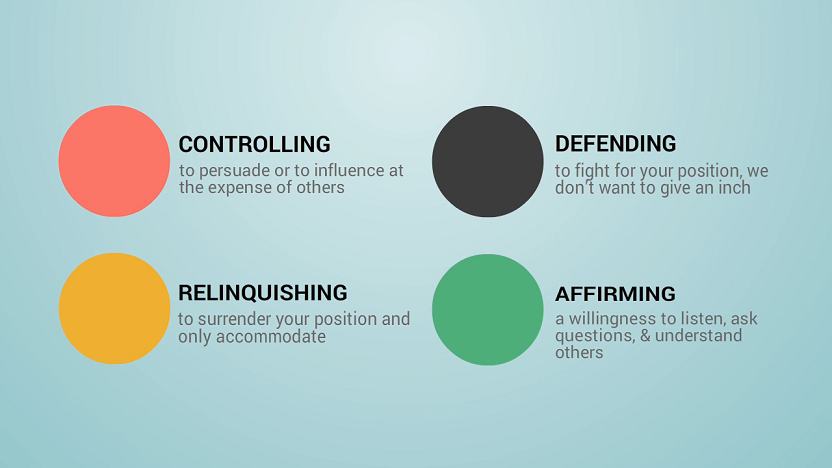
The Four Types of Intent
Understanding intent is key to improving the quality of communication. This post describes the four types of intent in detail and provides useful tips for people who want to display positive intent.
Introduction
There are four types of intent that underlie all communication: affirming, controlling, defending, and withdrawing. Everyone displays all four types of intent, but the object of excellent communicators is an affirming intent.
Here’s what each type of intent feels like.
An affirming intent feels like this: Your mind is open, your body feels relaxed and confident, you feel open to hearing other points of view, you feel you’re in a position of strength because you have a high level of confidence in the people around you. You know that the best outcome is likely to come when everyone is sharing his or her points of view openly, no matter how challenging, letting the best rationale win the day.
A controlling intent feels like this: Your mind is focused on achieving a specific outcome and advocating a specific position; you want to limit debate and discussion and options; you’re not all that receptive to other points of view. Your body is somewhat stressed, you certainly don’t feel relaxed. You’re not confident that an open sharing of viewpoints will result in an outcome that is best – probably because you sense a conflict between your agenda and other people’s.
A defending intent feels like your mind is back-pedaling. You’re trying to defend a position against what you perceive to be an attack. You can feel the emotion inside triggering higher levels of adrenaline. Your focus is on protecting yourself against an opponent whom you perceive to be formidable. Your pride and your reputation feel at stake. Typically your communication becomes shriller and more barbed, less relaxed and less productive.
A withdrawing intent feels like this: You feel burnt up. You have stopped talking and listening. You’d like to get up and walk out. Mentally you already have. The only thing preventing you from physically removing yourself is the feeling that it would cause further embarrassment and damage to your reputation. Communication is done for the day until you have a chance to regroup and get a clearer perspective on your value to the group.
Improving Communication
It’s easy to have an affirming intent when you feel comfortable with the people around you. When your intent is affirming, then your communication is naturally open, relaxed, and friendly. You are curious to hear other people’s ideas; you’re open to sharing your own. In short, you’re a brilliant communicator.
The challenge comes when you feel threatened. All of a sudden your intent shifts into a controlling or defending mode. If things go badly, your intent might shift further into withdrawal. The sooner you can shift back, the better. The trick is to make yourself aware of the change in your intent, decide to do something about it, and then take the right course of action.
How to shift gears into an affirming intent:
- Find a way to relax. Breathe deeply. Laugh. Think of things that make you happy. Allow yourself to enjoy whatever you are doing, however you choose to enjoy it. If necessary, get up and take a break. Jog around the block. In short, change your physical mood and let that work some magic on your psyche. As psychologists say: “Act yourself into a way of feeling.”
- Focus on understanding why you feel threatened, and ascertain whether it’s a legitimate threat or simply your own “stuff” being transferred to another person. If you come to realize it’s your own stuff, then that awareness may help you feel more relaxed. If possible, jot down your awareness, refer to it later and discuss with a trusted friend why it happens.
- Focus on your strengths – what you do well. If someone else is bugging you, focus on their strengths, too, and say something appreciative about them. And remember that no one has absolute clarity or the gift of perfection. Business teams and organizational groups are filled with a wild assortment of imperfect human beings who need each other’s help and support to achieve productive communication and decisions. You’re one of them. Relax and join in.
| Lesson 6: The Matrix of Communication Styles | Lesson 8: Four Authentic Communication Skills |
5 Comments
Add yours+ Leave a Comment
You must be logged in to post a comment.



[…] Lesson 7: The Four Types of Intent […]
[…] Lesson 7: The Four Types of Intent […]
[…] This post was originally published at CommunicationStyles.org. […]
[…] easy to say, hard to do. Much of our behavior is defensive. If someone challenges our views, it is ingrained in us to respond defensively, to challenge the other person’s ability to see things clearly. In so doing, we shift the focus […]
[…] communicators are also conscious of their intent and can vary it. There are four types of intent: affirmative, controlling, defensive, and relinquishing. Only the first is positive. The others […]